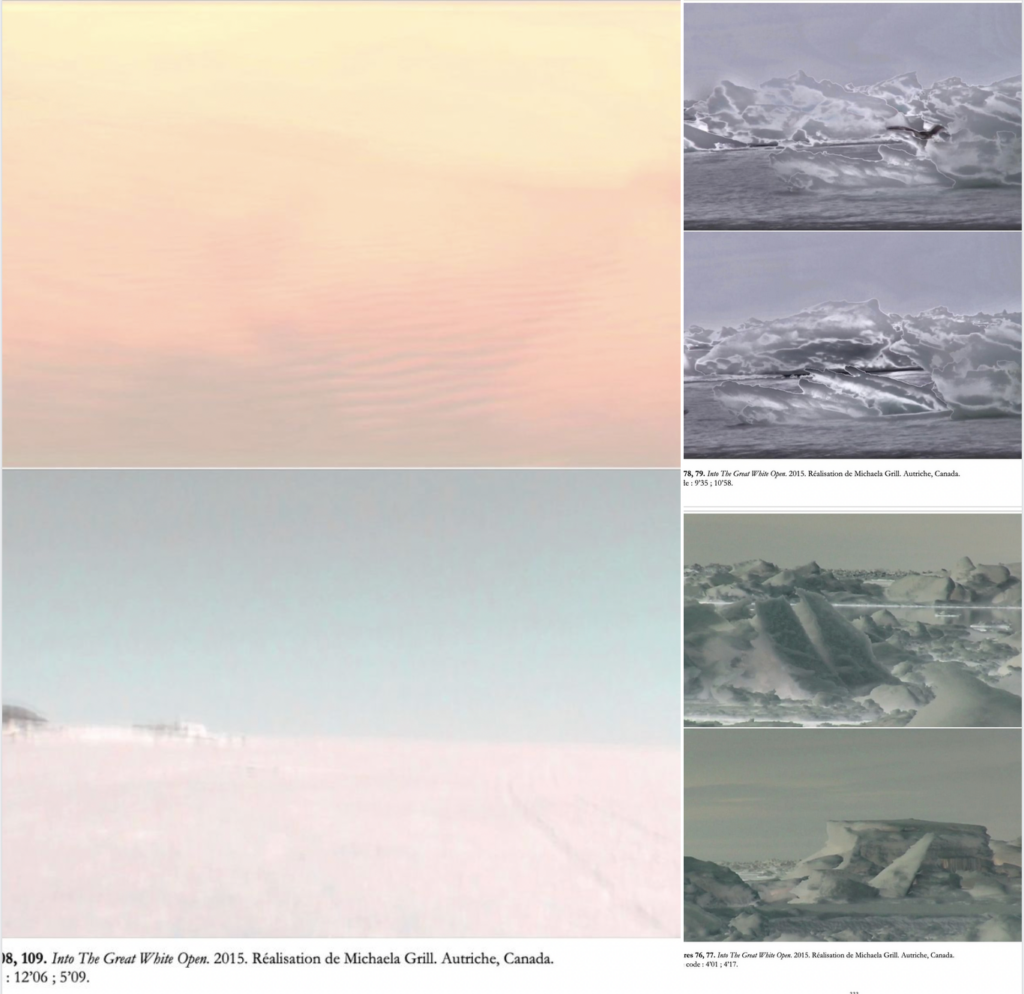
BIBLIOGRAPHY
Steve Bates: Michaela Grill: Vibrating Currents in: Austrian Avantgarde Cinema, edited
by Peter Tscherkassky, Synema/Filmmuseum Publishing, 2012. p. 286-293.
Christa Benzer: Rock’n’Roll Will Never Die. Zu den Musikvideos, Live-Visuals und
Installationen der Videokünstlerin Michaela Grill in: springerin. Hefte für
Gegenwartskunst, Summer 2003.
Kornelia Boczkowska: Lost Highways, Embodied Travels: The Road Movie in American Experimental Film and Video. Brill, 2023.
Cécile Delignou: L’altération filmique : pour une expression écocentrique de la nature. Thesis at Université de Montréal, Papyrus, 2024
Petra Erdmann: Weiß auf Weiß im Videomix. Aktuelle Electronica-Videos bei der
Diagonale in: springerin BdIII, Heft 2, 2000 p. 12-13.
Michaela Grill/Christof Kurzmann: Place Becomes Time, Space Becomes Mine. O.K.
spektral Exhibition catalogue 2.10.2004-14.11.2004. ed. by O.K. Centrum für
Gegenwartskunst, curated by Roland Schöny.
Christian Höller: Filme ohne Story in: Spike 01, Vienna Oct 04.
Christian Höller: Wegfliegen, ohne sich dabei auf die Federn zu treten/ Flying away
without treading on your wings, in Projektraum Project Space 2013-2013, hg. Vom
Kunsthaus Graz, Graz 2014, p. 56- 69
Maria Motter im Gespräch mit Barbara Pichler und Michaela Grill: Von der bizarren
Schönheit von Nichtorten in: HDA Magazin 1/2009.
Barbara Pichler: En quête de traces – remarques sur des phénomènes (marginaux)
typiquement autrichiens in: Austriaca nr 64, 2007 p. 127-138 (publications des
Universités de Rouen et du Harre, ed. by Christa Blümlinger).
Barbara Pichler: Von New Electronica zum Transgender-Cyborg in: Telepolis.
Zeitschrift für Netzkultur 29.3.1999.
Barbara Pichler: Die Kunst der Abstraktion in: Kolik 1/2004, p44.
Isabella Reicher: Metamorphosen und Energiefelder. Digitale Filmkunst im Kino: „Goldt trifft Grill“ in: Der Standard 28.9.2004.
Claudia Slanar: Der Durchbruch ins Reale. Michaela Grills Videoarbeiten zwischen Abstraktion, Reduktion und Vermischung in Eine eigene Geschichtre. Frauen Film Österreich seit 1999, ed by Isabella Reicher, Sonderzahl Verlag 2020, p 279-287
Claudia Slanar: Land in Sicht. Beobachtungen zur Ikonografie der Landschaft in
neueren, experimentellen Videos und Filmen aus Österreich in: moving landscapes.
Landschaft und Film ed. by Barabara Pichler and Andrea Pollach, SYNEMA Vienna
2006, p. 209-221.
Claudia Slanar: Off the Grid. Zu einigen Videos von Michaela Grill, in Kolik 19/2013, p. 49-53
Mark Webber: Counting the Waves: A Summery of Activity in: senses of cinema,
www.sensesofcinema.com, 2003.
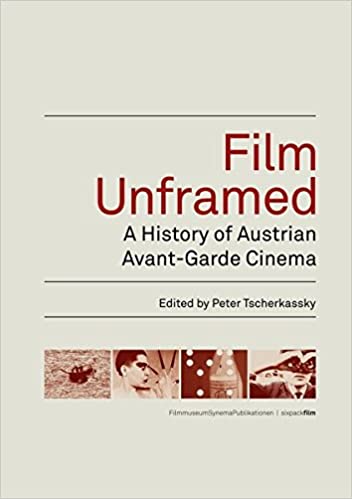



Stefan Grissemann: Stadt, Land, Maschine. Zur Arbeit der Videokünstlerin Michaela Grill in Diagonale Katalog 2013
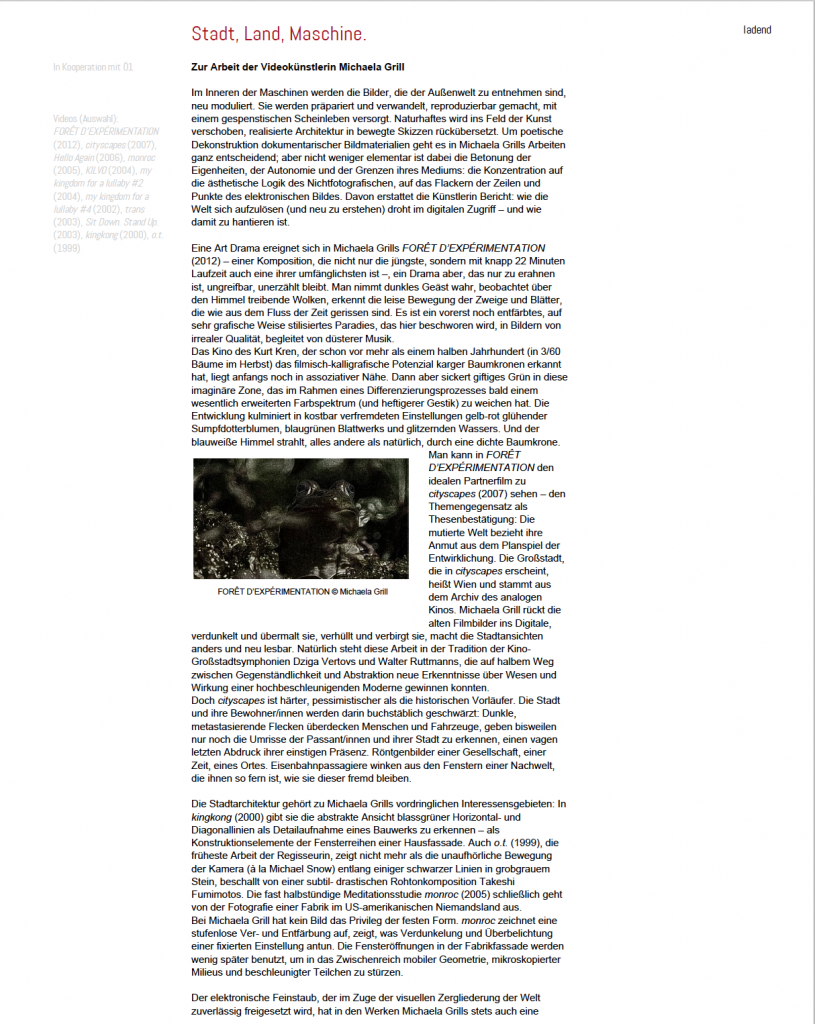
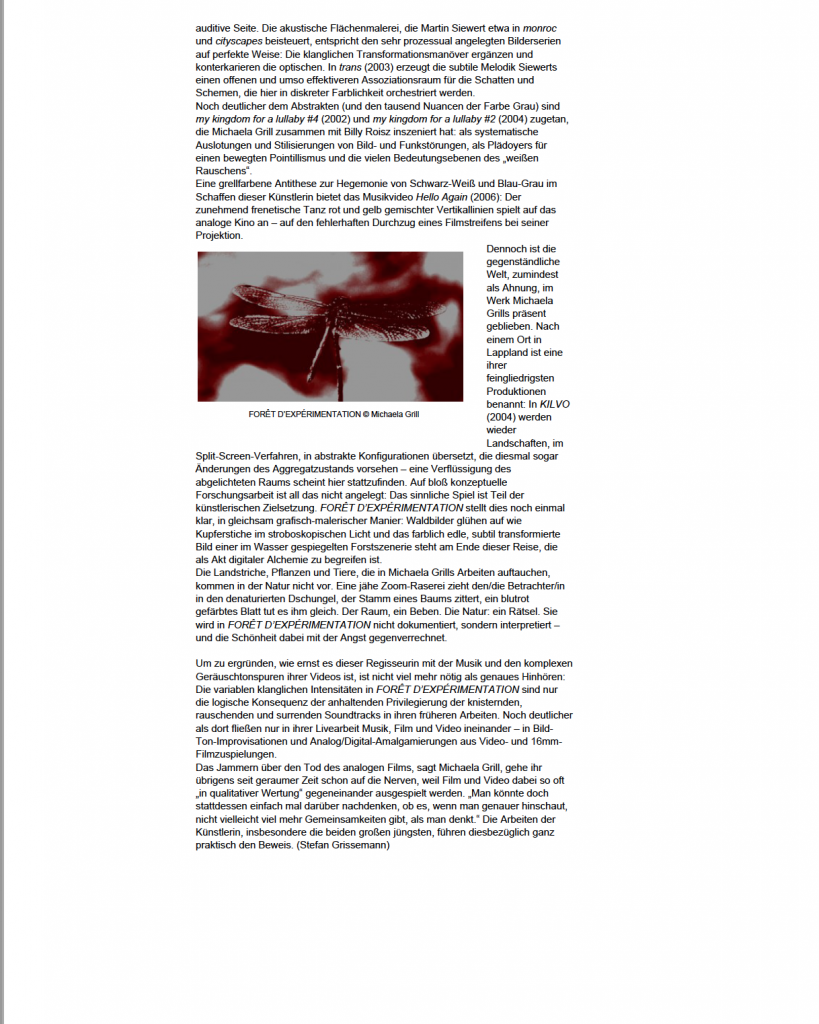
Steve Bates: Michaela Grill: Vibrating Currents in: Austrian Avantgarde Cinema, edited by Peter Tscherkassky, Synema/Filmmuseum Publishing, 2012.
Christa Benzer: Rock’n’Roll Will Never Die. Zu den Musikvideos, Live-Visuals und
Installationen der Videokünstlerin Michaela Grill in: springerin. Hefte für
Gegenwartskunst, Summer 2003.
One of the most recent works the Austrian artist Michaela Grill has produced jointly with Billy Roisz bears the catchy title »Rock’n’Roll Will Never Die«. In this title, the two artists refer very seriously to their musical roots. The raw material of the soundless video is the documentation of a concert by Christof Kurzmann, Toshima Nakamura and Martin Siewert at the Saalfelden Jazz Festival. The video was intended not least as a visual commentary on the fact that the sensory complexity of electronic music production is reproduced almost solely by means of abstract digital data. However, one does not only see the musicians with their laptops, concentrating on their performance, but an equally concentrated audience and a screen dominating the stage. It could be presumed that the musicians are »accompanying« the pictures, an impression that already leads to the aural element being subordinated to the visual one. And, indeed, every combination of audio and visual elements raises questions about the production process, about media hierarchies. The fact that this process, which mostly involves a relatively limited number of different groupings of videomakers and musicians associated with Michaela Grill, is constantly being reexamined is not simply because of their love of experiment. Rather, there is a very basic artistic approach in play here: firstly, image and sound should not merge pleasantly with one another, but maintain their recalcitrance and independence; secondly, these intermedia cooperations are predicated on collective artistic practices; and, thirdly, the inclusion of a context-related examination of the raw acoustic and visual material is meant to operate on the viewers’ habitual perceptive criteria.
These various principles come to fruition in the videos, live visuals and installations produced by Grill since 1999. While her first music video, »o.T.«, which as such accorded to usual cinematic expectations, eroded habits of seeing and listening by having the camera race over a cement wall to the music by Takeshi Fumimoto, the live visuals and installations are not only mostly based on a story, but – related to this – on a reflection on the narrative method and its implicit patterns of reception. One example of this is the project »Boiled Frogs«, which the artist, whose works had already been shown at prestigious music and film festivals (Avanto/Helsinki, Sonar/Barcelona, Underground Film Festival/New York, Filmfestival/Rotterdam, etc.), conceived in 2000 with Christof Kurzmann for the »steirischer herbst« festival.
»Boiled Frogs« was based on a macabre scientific study that demonstrated how frogs thrown into hot water try to get out of it as fast as possible while, when water is heated slowly, they remain in it until the process of adaptation reaches its fatal conclusion. The work tested the perceptive capacities of the viewers. The growing intensity of the image-carriers hanging in the room and of the live music was intoxicating, and the warning given by Tony Conrad (minimal music pioneer and inventor of the »flicker effect«), »What you’re going to see is potentially hazardous for photogenic epileptics or photogenic migraine sufferers«, could not only be applied to this evening, but also to the project »Trapist Extended« (2003). This project was about »practised attitudes of making music« (Martin Siewert) in the so-called »Theater of Eternal Music« (La Monte Young, Tony Conrad, John Cale, Robbie Basho and John Fahey, among others) and the structural, collective and improvisatory approaches that inform this music. Michaela Grill’s experiments with the visual curiosity of the viewers took its bearings from the cinematic works of Tony Conrad and his interest in the effects that pulsating colour patterns have on the human perceptive apparatus. While, in »Trapist Extended«, the artist deliberately saw her images as »accompaniment«, the live experiment »My Kingdom for a Lullaby« (2001) was an ambitious attempt at an improvised orchestral interaction between the video artists and musicians: prepared video material that Michaela Grill and Billy Roisz visually generated from basic sounds of the instruments (guitar, theremin, G3 etc.) were combined live with newly produced image material, which in its turn was used to drive the music. The deliberate use of basic material was also the central theme in the live act »Die Instabilität der Symmetrie« (The Instability of Symmetry) (2002), which was realised by Michaela Grill and the musicians Martin Brandlmayr, Werner Dafeldecker, Stefan Németh and Martin Siewert as part of MAK NITE. The concept envisaged the »critical examination of the phenomenon of the exploitation of basic material, which, in the course of its mostly digital reprocessing (particularly in an era in which there is a flourishing remix and sample culture), loses any socio-cultural or art theoretical context inherent in the initial work«.
In logical consequence, the musicians limited themselves solely to acoustic material that was created in the course of the project. On the screens, which could be seen as independent image-carriers on the left and right behind the stage, Michaela alienated scenes from classical Hollywood films to the point that they became unrecognisable. This seemed to be diametrically opposed to the basic concept, but in fact wasn’t. Her decontextualisation of these dominant images that, as we known, profoundly infiltrate perception, resembled a visual tabula rasa, as the lack of recognisability undermined every mode of explanation, thus greatly increasing the intensity of the sensory experience. Michaela Grill’s engagement with film history reached its climax in »re:store« (together with Martin Brandlmayr, Werner Dafeldecker, Dean Roberts and Martin Siewert), which was screened in November 2002 in the Austrian Film Museum to celebrate the 12th birthday of Sixpack Film. From the archives of these two institutions, which both give important support to the audio-visual scene, Grill put together an independent film that, with its subverted narrative structure, causes the audience’s concentration to be absorbed completely by atmospheric elements – as with »re:store«.
By contrast, in her latest music video, »trans«, which received an award at this year’s Diagonale festival, the narrative rules of classical drama are elevated to the status of a formal principle: the tension is produced by an introduction, an exposition, an exciting element and its resolution. Even in an extremely abstract version, this complex narrative structure, which is reduced to the basic elements of film (bright/dark, movement/motionlessness), still retains the ability to fascinate. This can only be put down an irrational component that must have to do with the artist’s visual sensitivity. The fact that this sensitivity was trained to a not inconsiderable extent by years of watching MTV takes us back to the incantation of the male-dominated rock culture mentioned at the start, boldly appropriated by two women.
Christian Höller: Film Musik Gespräche. Das Fragmentarische ist die Erzählung
Pablo Marin, BAFICI catalogue

Claudia Slanar, Der Durchbruch des Realen. Michaela Grills Videoarbeiten zwischen Abstraktion, Reduktion und Vermischung in Eine eigene Geschichtre. Frauen Film Österreich seit 1999, ed by Isabella Reicher, Sonderzahl Verlag 2020, p 279-287
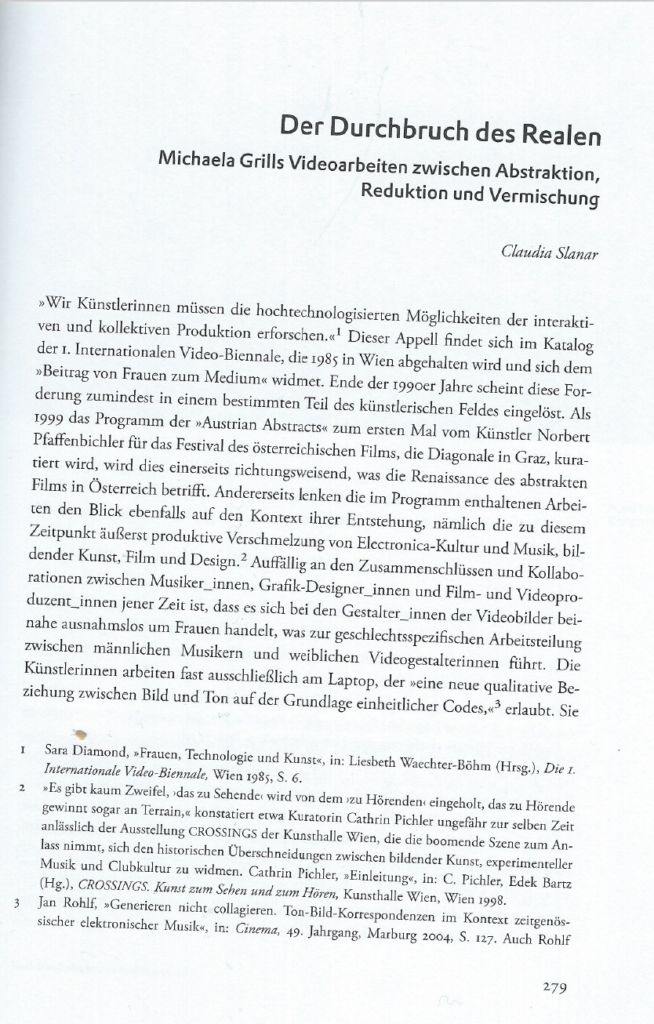
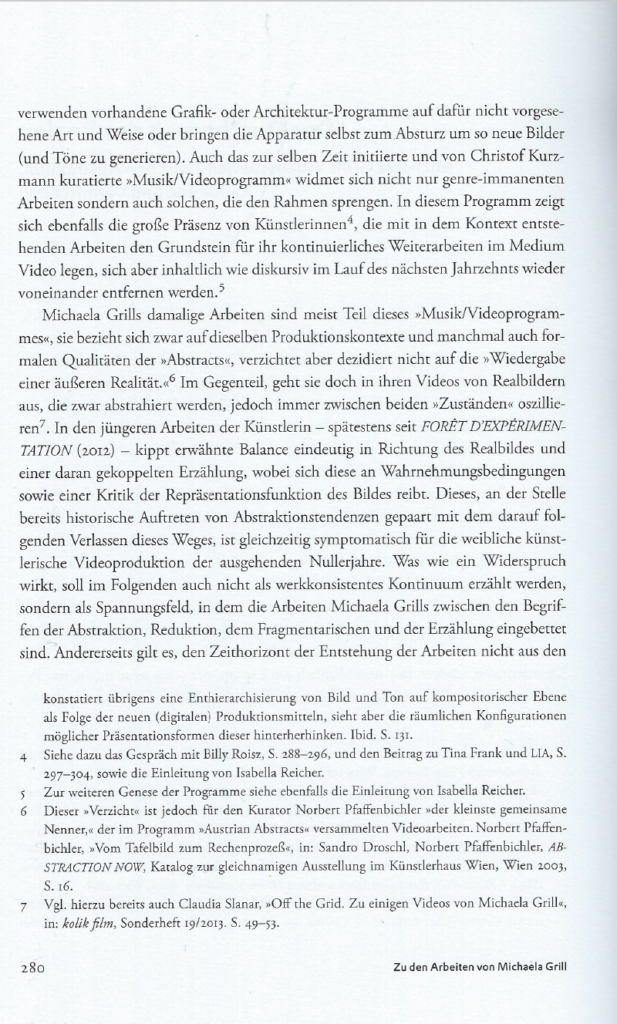
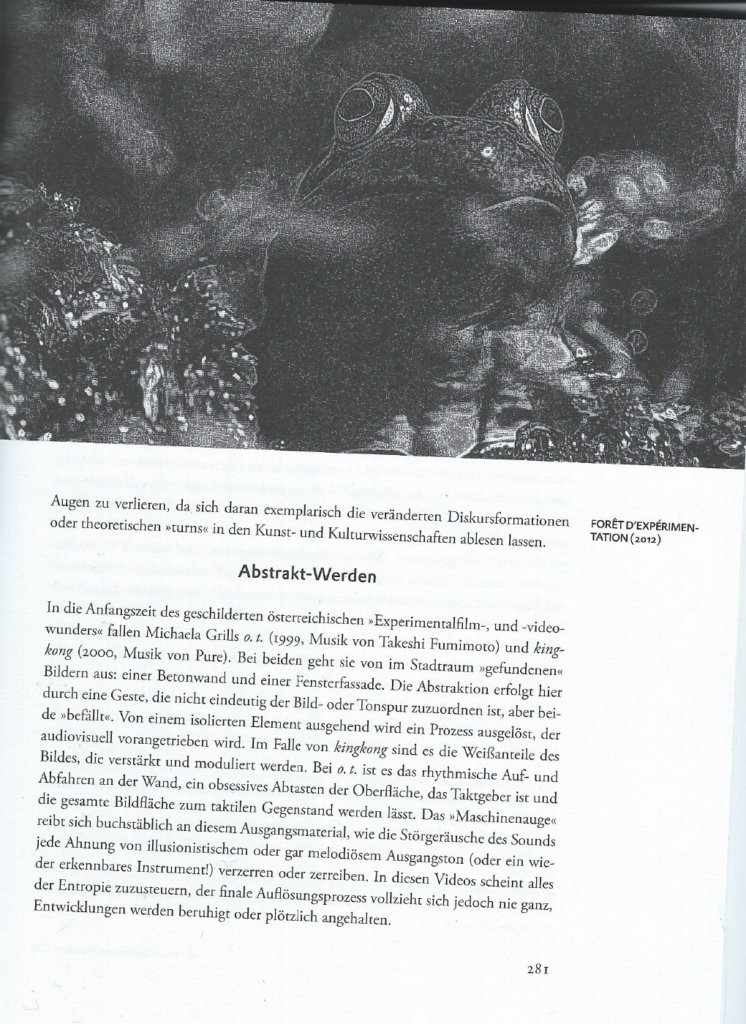
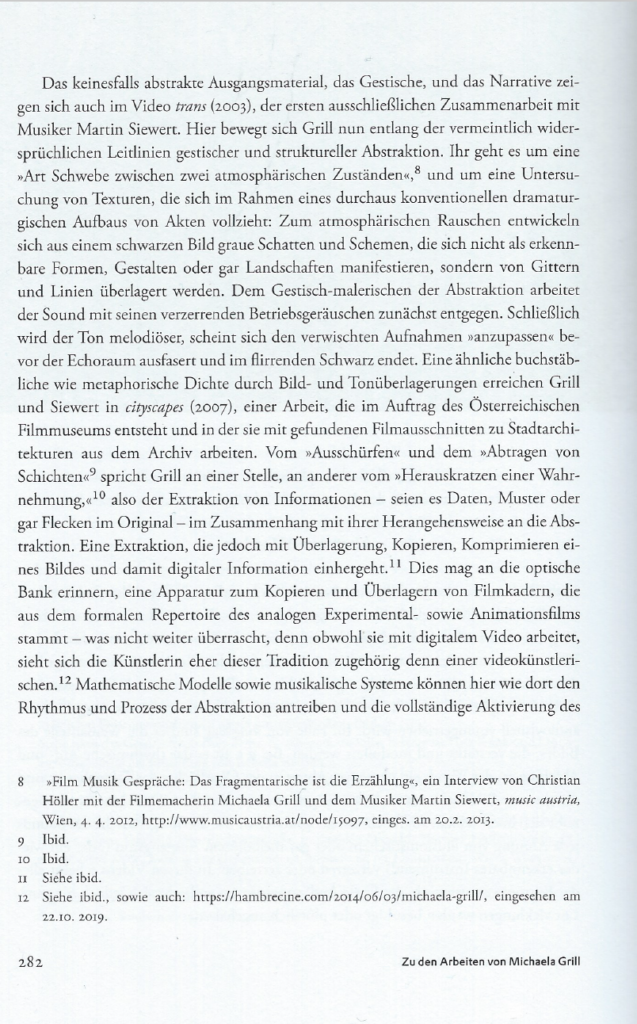
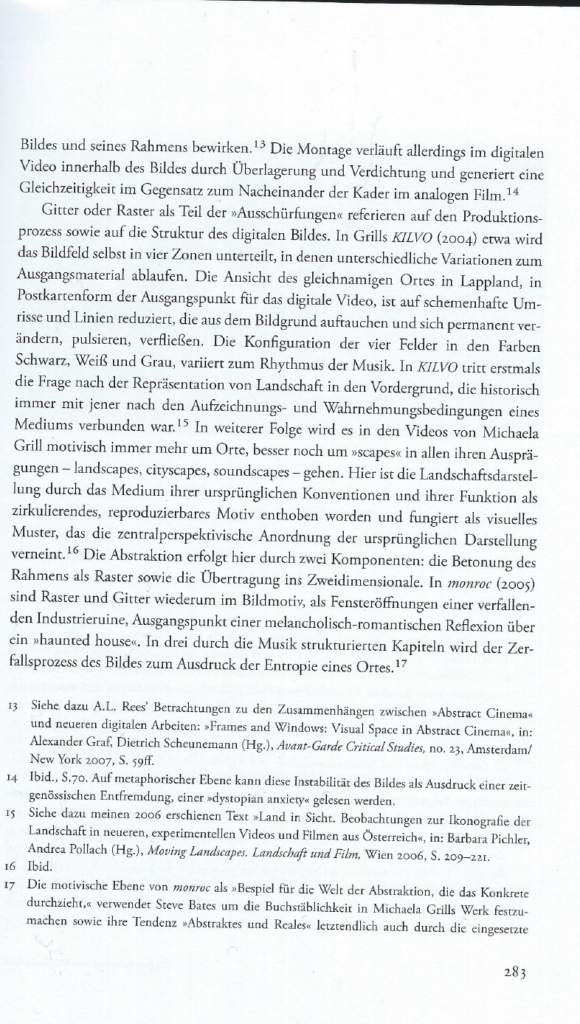
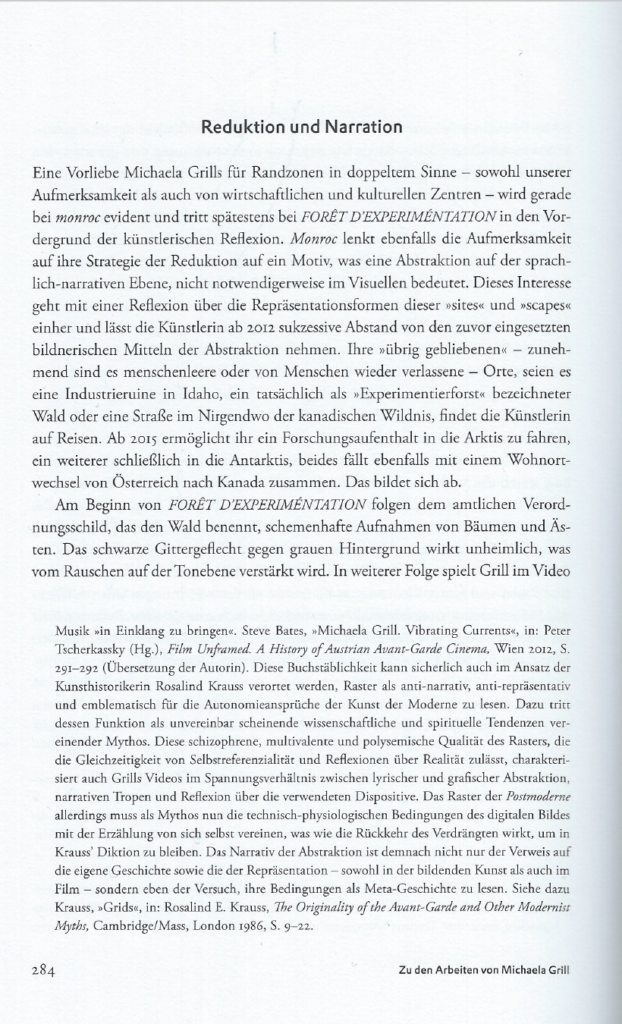
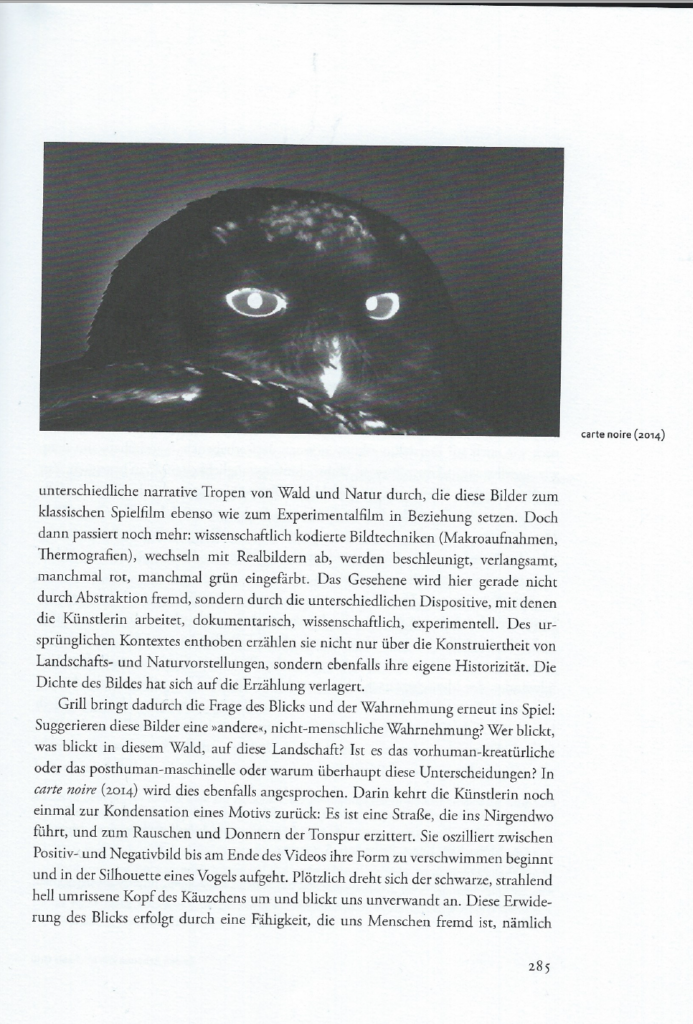
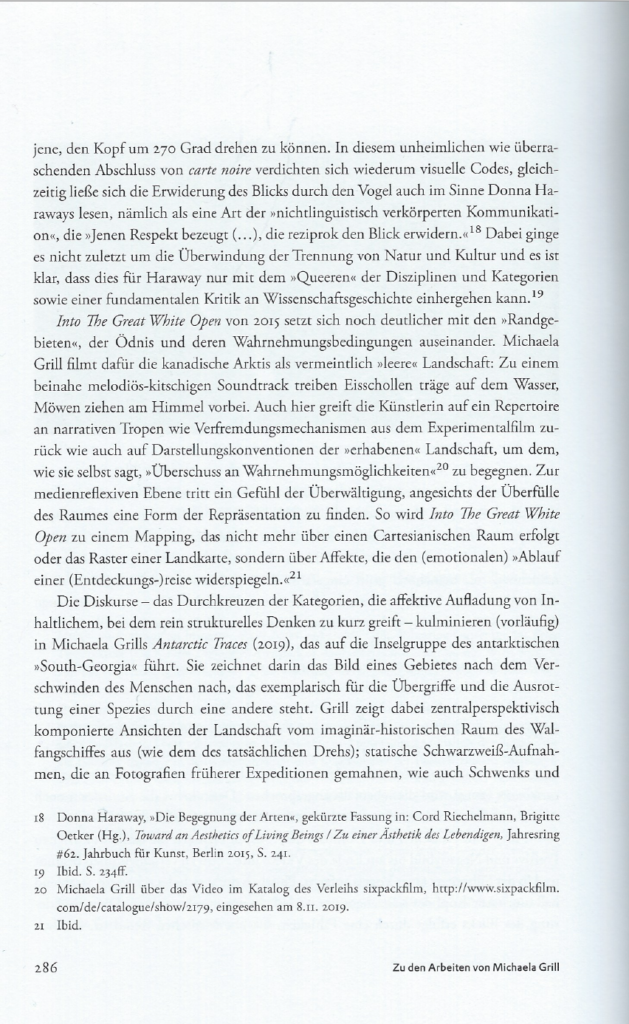
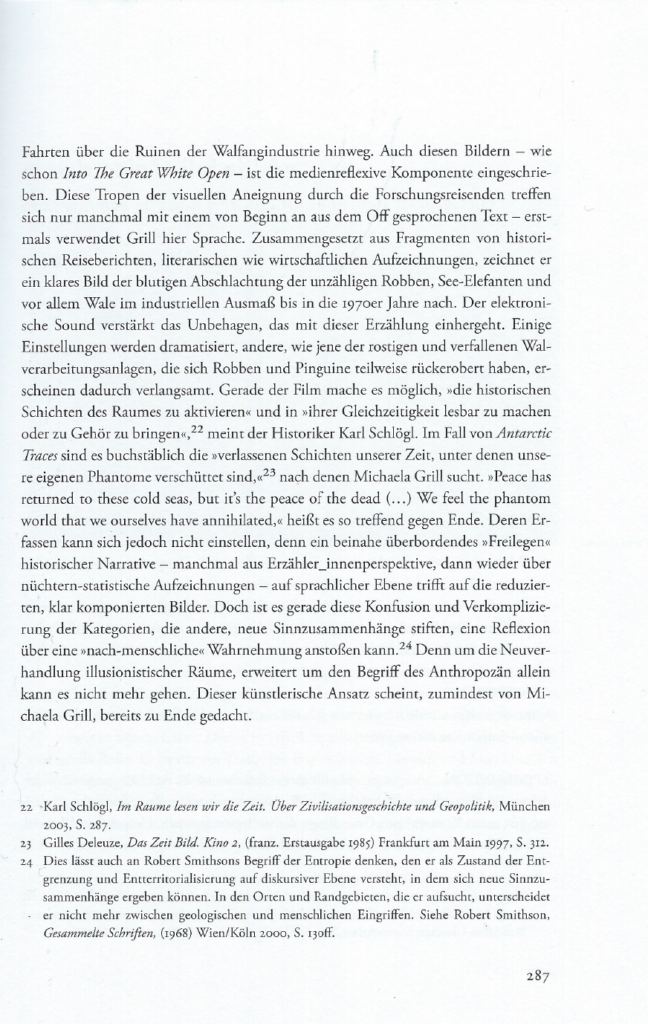
Cécile Delignou: L’altération filmique : pour une expression écocentrique de la nature:
https://hdl.handle.net/1866/32773
